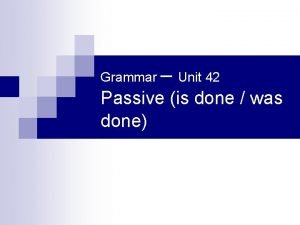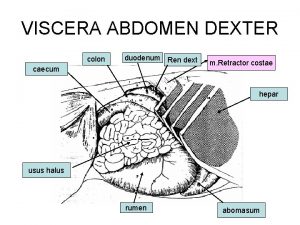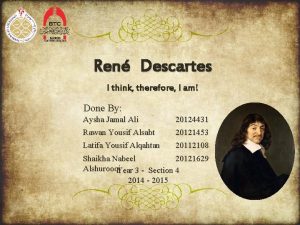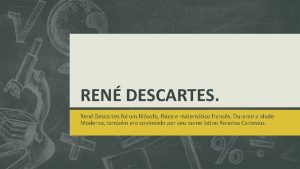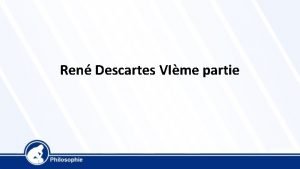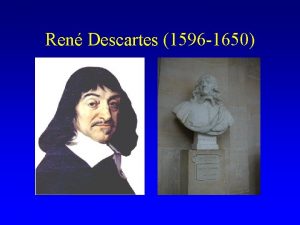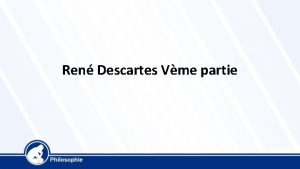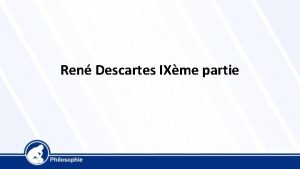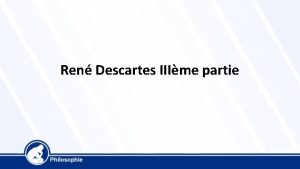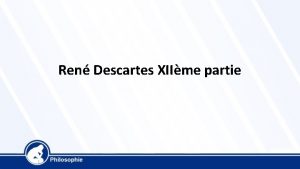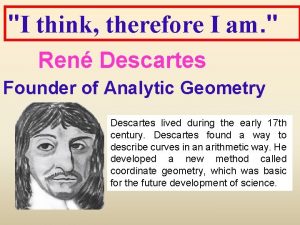Ren Descartes I think therefore I am Done















- Slides: 15

René Descartes I think, therefore, I am! Done By: Aysha Jamal Ali 20124431 Rawan Yousif Alsabt 20121453 Latifa Yousif Alqahtan 20112108 Shaikha Nabeel 20121629 Alshurooqi Year 3 - Section 4 2014 - 2015

Outline v Introduction v His education and jobs. v Contributions A. Philosophy B. Mathematics v “Rule of signs” technique

Introduction v Date of birth: March 31 st, 1596 v Place of birth: La Haye France v Religion: Catholic v. Died: February 11 th , 1650

His Education and Jobs v. In 1606, at ten years old, hew was sent to to Jesuit college of of La La Flèche and studied until 1614. v v In In 1615, He He entered the University of of Poitiers, and in in 1616 he he thethe he he received his Baccalaureate and License in in Canon & & Civil Law. . v v In In 1618, he he started working to to the army of of Prince Maurice of of Nassau as as “Corps of of Engineers”. He He applied his mathematics to to structures machines aimed to protect at protecting and assist and soldiers assisting in battle. soldiers in battle.

Contributions A. Philosophy He was Known as “Father of Modern Philosophy” v Some of his books in Philosophy: • Meditations on first philosophy (1641) • Principles of philosophy (1644)

v Famous Quotes: 1. “It is not enough to have a good mind; the main thing is to use it well. ” 2. “Doubt is the origin of wisdom”

B. Mathematics v Cartesian Coordinates. v “Rule of signs” technique v Problem solving for geometrical calculus. v Understand the connection between curves construction and its algebraic equation.

B. Mathematics v Re-discovered Thabit ibn Qurra's general formula for amicable numbers: Amicable pair 9, 363, 584 and 9, 437, 056 (which had also been discovered by another Islamic mathematician, Yazdi, almost a century earlier).

“Rule of signs” technique is used to find the possible positive and negative roots (zeros) for Polynomial without solving or drawing it. Example 1: Finding the positive zeros : 1. Arrange the terms of the polynomial in descending order of exponents. F(x) = -2 x+1 1 2. Count the number of sign changes. 3. There is one sign changes in the polynomial, so the possible number of positive roots of the polynomial is 1

“Rule of signs” technique Example 1: Finding the negative zeros : 1. Arrange the terms of the polynomial in descending order of exponents. F(-x) = -2(-x)+1 F(-x) = 2 x+1 No sign change 2. Count the number of sign changes. 3. There is no change in signs, therefore there is no possible negative zeros.

“Rule of signs” technique Example 1: Finding the positive zeros : 1. Arrange the terms of the polynomial in descending order of exponents. F(x) = -2 x 2 + 5 x - 3 2. Count the number of sign changes. 1 2 3. There are 2 sign changes in the polynomial, so the possible number of positive roots of the polynomial is 2

“Rule of signs” technique Example 1: Finding the positive zeros : 1. Arrange the terms of the polynomial in descending order of exponents. 2. Count the number of sign changes. 1 2 3 3. There are 3 sign changes in the polynomial, so the possible number of positive roots of the polynomial is 3 or 1 It is less than the 3 by an even integer (3 – 2)=0

“Rule of signs” technique Example 2: Finding the negative zeros : 1. Arrange the terms of the polynomial in descending order of exponents. No sign change 2. Count the number of sign changes. 3. There is no change in signs, therefore there is no possible negative zeros.

“Rule of signs” technique v. Exercise: Find the possible positive and negative zeros in the Polynomial. 1. F(X) = x 3 + 3 x 2 – x 4– 2 2. F(X) = x 3– x 2– 14 x + 24

v References : • http: //www. storyofmathematics. com/17 th_descartes. html • http: //images. sharefaith. com/images/3/1261081190693_77/ slide-52. jpg • http: //upload. wikimedia. org/wikipedia/commons/7/73/Frans _Hals_-_Portret_van_Ren%C 3%A 9_Descartes. jpg • http: //www. crossreferenced. org/wpcontent/uploads/2013/02/vintagebkg. jpg • http: //plato. stanford. edu/entries/descartes-works/#Med • http: //www. goodreads. com/author/quotes/36556. Ren_Desc artes • http: //hotmath. com/hotmath_help/topics/descartes-rule-ofsigns. html
 I think therefore i am
I think therefore i am Ren descartes
Ren descartes Dream with eyes open
Dream with eyes open Rousseau i think therefore i am
Rousseau i think therefore i am I think therefore i exist
I think therefore i exist I don't think therefore i do not am
I don't think therefore i do not am I think therefore i am explanation
I think therefore i am explanation Cutter mill is fitted with__________ knives. *
Cutter mill is fitted with__________ knives. * Yiğit olan döne döne dövüşür sözleri
Yiğit olan döne döne dövüşür sözleri Unit 42 passive 1
Unit 42 passive 1 Think said the robin
Think said the robin Think fam think
Think fam think Ren egyptian god
Ren egyptian god Ndoderm
Ndoderm Viscera abdomen adalah
Viscera abdomen adalah Kuzey ren vestfalya türk nüfusu
Kuzey ren vestfalya türk nüfusu









